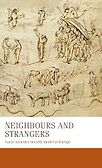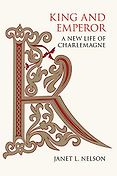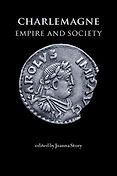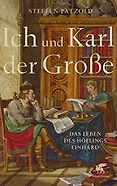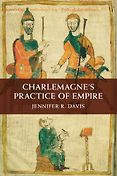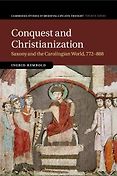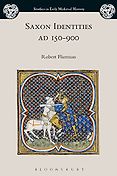Before we get to the books, could you just tell us, very briefly, when Charlemagne was around and also when Charles became Charles the Great—Charlemagne.
Charlemagne was born halfway through the eighth century and died in 814. It was a period when Europe was undergoing enormous changes. The Roman Empire had disappeared, more or less. There was a Merovingian dynasty that had just been exiled and Charlemagne’s father became king. At that point, Charlemagne was three years old. We are talking about a new dynasty here that came to power in a palace coup. Charles’s father was Pippin—Pippin III, we call him now. He played a very clever game, helped by the Pope, to oust the last Merovingian king, who was from a legitimate dynasty that had been on the throne for two and a half centuries. By really clever manoeuvring, Pippin managed to become the King of the Franks.
His son, Charles, was just ‘Charles’. He became ‘Charlemagne’ after his death. He succeeded his father and, like many sons who succeed a royal father, he tried to outdo his father in every possible way. And that worked for all kinds of reasons. We know him as the first emperor in the West after the Roman period and the man who conquered most of what is now Western Europe, more or less.
After the Second World War he became ‘the Father of Europe’. You can approve of that or not. I feel a bit uncomfortable with it.
There’s also a ‘Prix Charlemagne.’ What’s that awarded for?
It is awarded by the City of Aachen, which was home to Charlemagne’s palace. It’s given to people who have helped Europe ‘become one’. There is a nice Wikipedia page about it, with a list of all the people who have won the ‘Prix Charlemagne’ or the ‘Karlspreis’. That’s another thing about him: are we talking about ‘Karl der Grosse’ or ‘Charlemagne’? He’s a different person to different people. That is what makes him so interesting.
When was the appellation ‘the Great’ bestowed on him?
Once he was safely in his grave and the Carolingian Empire that he had built began to be divided into sub-kingdoms, some writers of history started to call him ‘the Great’. It took off in the 12th century. All of a sudden, he’s the hero of crusader romances. He becomes a very appealing figure of fiction from the high Middle Ages onwards, and that never stops.
He’s a saint in the Christian church as well, isn’t he?
Unfortunately he was canonised by an anti-Pope; it was a political thing. There are some churches in parts of France where you can still find statues to Saint Charlemagne, but I don’t think he’s made the official calendar. There was an attempt to get him on and some people and some areas of Europe still stick to that. That’s another strange chapter in the history of this man. He pushed so many buttons, mostly after he was dead, that he became many different things—many unrelated to what he actually was.
We just know very little about this guy. Johannes Fried, a prominent German medievalist, published an 800-page biography of Charlemagne on the basis of what we know about him, which is virtually nothing. Of course, as a historian, there are all kinds of tricks that you can pull out of your box to flesh out the little bits and pieces that you do have.
If you read biographies of Charlemagne from, say, the 18th century to now, you’ll learn a lot about historians and what they were interested in and what they were trying to project upon this man, but less about him. Even in the 1950s, there were still people who thought that Charlemagne was a lone genius who wanted to resurrect the Roman Empire, more or less single-handedly; that he was this lonely visionary in a barbarian world. This was when people still believed in ‘the Dark Ages’. That is not that long ago but things have moved on quite a lot since then.
Let’s move on to the books. The first one is by Janet Nelson, King and Emperor: A New Life of Charlemagne. Of all the books you could have chosen, why is this the best biography of Charlemagne?
If you ever want to read one book on Charlemagne, then this would be the one. It’s wonderful. A whole raft of biographies came out around 2014 to commemorate 1200 years since his death. Nelson’s book came out a little bit later. She has worked on Charlemagne for half a century. Still, she manages to reread all the primary sources. She knows her stuff: every little scrap of information—be it archaeology, art history, history, or some strange manuscript in an obscure German monastery. She has it all and she manages to use these bits and pieces as part of a big puzzle, most of which is missing. She doesn’t try to tell us a coherent, working story that starts with birth and ends at death and mechanically goes through the points in between. She tells us what we don’t know as well, and she tries to make the most of the bits and pieces we have. She also shows how difficult it is to interpret them sometimes.
“We know him as the first emperor in the West after the Roman period and the man who conquered most of what is now Western Europe, more or less”
In the introduction, she says she wants to make the sources speak. And that is what I find so wonderful about this book. She interprets them, but the main characters in her book are all these bits and pieces of evidence through which we can get an idea about who Charlemagne was and why he is interesting. It is wonderful to have the primary sources at the heart of the book and she makes space for them. She points out things that are strange, or contradictions between sources and asks, ‘What can we make of that?’ which I love.
Many biographies of Charlemagne have been written, but this reads as a really fresh and interesting new take on the whole story.
Although she’s obviously more tentative because, in a way, she’s more thorough than lots of her predecessors, does she come up with a particular view or understanding of Charlemagne’s place in history, of his role, or what he achieved? Or does she deliberately shy away from those sorts of conclusions?
One thing she deliberately does not do is fall into the trap of writing with hindsight. She calls him Charles because ‘Charlemagne’ was a later development in the story. And she tries to stick as much as she can to contemporary material, to really zoom in on what was happening, not what people later said had been happening. That’s a big difference.
Her Charlemagne is not the lone genius, trying to rebuild the Roman Empire. Her Charlemagne is somebody who sometimes messed up monumentally but was very good at improvising. He is someone who had to learn how to rule this enormous empire just by doing it and trying things out, and by trusting people. Sometimes that was not a very good idea, as it turned out. He’s somebody who was very good at thinking on his feet and who was a very energetic person and interested in a lot of things.
He’s not the big emperor with a crown on his head and a big flowing beard, sitting on the throne and ‘ruling’. No, he’s running up and down his empire all the time because there were people attacking it and people being unfaithful. He was a very busy emperor.
He may not have resurrected the Roman Empire in the West, but he did get himself crowned Emperor of the Romans in 800, so there was something going on there. What allowed him to build this empire? Was it weakness in the surrounding polities, or was he driven by anxieties about the illegitimacy of his dynasty, and felt he had to be more energetic in keeping his aristocracy on board by invading other countries? What was behind the strength of his state, in as far as it existed?
That’s a very good question. And, of course, you can have a long discussion about whether or not this was a ‘state’ in any modern sense of the word. I think there are several parts to the secret of his success. One is simply that he was a very good military leader, with a bigger and stronger army than the neighbours. He certainly profited from weaknesses in neighbouring areas.
But I think you can also say that he wasn’t building an empire. It wasn’t a conscious process, where he woke up one morning, wondered what he should do that weekend, and decided to build an empire. Even the imperial coronation has some issues of interpretation. What he needed to do, given the kind of rule he was exercising, was to make sure that the people who were faithful to him—his military leaders, his commanders, his counts—stayed faithful. Since this is not a state as we know it, with a separate army, you need to make sure that these people stay happy. And one way of keeping them happy is to win wars and to divide the plunder with them. This stage of early medieval history has been labelled a ‘plunder economy’—because you need to expand in order to keep this internal balance. A count who gets a nice chunk of treasure to take home to his wife and children will come back and fight for you again.
“We just know very little about this guy”
That is something that starts to get harder under Charlemagne’s grandsons when the Empire gets divided. Then, you have three kings to choose from, and sometimes even four. So, if one doesn’t pay you enough, you simply go to the neighbours.
But Charlemagne was good at this and, by winning some wars that produced really spectacular amounts of treasure, he had a nice base to work with.
The other thing is that he embraced Christianity as a way of life. Christianity, at the time, was more than what we would call a religion. By collaborating with the Pope he was certain that he ruled by the grace of God on Earth. That’s not only nice because then you get extra support from Heaven in your wars, if you need it, but it also comes with obligations, because it’s then your responsibility to save people who, like the Saxons for instance, are pagans. Saxony was conquered and converted at the same time. So, there is also this ideal of spreading Christianity, early medieval style. That is a building block as well, this idea of a Christian empire.
I don’t think that he was trying to revive the Roman Empire. This coronation in 800 is still a bit of a mystery. We have very conflicting stories about it. Charlemagne’s biographer, Einhard, says that Charlemagne had no idea that it was coming. According to Einhard, Charlemagne was there in Rome, in church on Christmas Day, happily praying at the grave of Saint Peter when the Pope sort of sneaked up behind him and put this crown on his head and said, ‘Hooray, we have an empire and an emperor!’
That’s not very likely, right?
It sounds slightly implausible.
But why does Einhard write this down? Others, later on, thought that this train of events was impossible and that Charlemagne must have planned it years and years ahead. But these contradictory stories are already a reason to think that something was going on here. Maybe the plan was not so much to revive the Roman Empire, but for the Pope to get a stronger ally, or to say thank you for some favours that Charlemagne had done him. Or something else.
Even once he was emperor, he didn’t use that title nearly as much as ‘King of the Franks and the Lombards’. It was a nice extra, but ‘the Emperor Charlemagne’ means something very different from whatever you want to understand by ‘the Roman Emperor’.
Let’s go on to the next book Charlemagne: Empire and Society, edited by Joanna Story.
This is a nice book for people who want a taster menu of Charlemagne. It consists of relatively short chapters on interesting aspects of Charlemagne and his world. It is a book aimed at beginners. I think it is the most recent and most accessible book of its kind on the market today.
Do its chapters address issues around Charlemagne where the academic debate is particularly lively at the moment?
This book is from 2005 and was intended to showcase the state of debate and of knowledge at the time. The ninth chapter in the book, written by Rosamond McKitterick, is on the Carolingian renaissance of culture and learning. That is a big debate at the moment because this idea of a ‘renaissance’ is hard to maintain. There is a question about whether we should be talking about ‘reform’ or ‘correctio’ instead.
“We have a few hundred Merovingian manuscripts left, written over a period of 250 years. Then, in the 150 years of the Carolingian period, you get 8,000 or 9,000 books remaining”
There is a question about whether this cultural flowering in Charlemagne’s day was about people at the court becoming very clever and sophisticated, without the rest of the empire noticing—this old idea that it is a small, elite phenomenon. More recent work has shown that this was not at all about elite culture, but part of a much broader idea of wanting to lead a whole population to salvation, for which they needed books. And these books needed to be everywhere, even in small churches and small villages.
Wasn’t the Carolingian Renaissance—or however we should be referring to it—partly about renewing or developing legal systems?
Yes, legal systems, educational systems. Books are a symptom of the bigger story. We have a few hundred Merovingian manuscripts left, written over a period of 250 years. Then, in the 150 years of the Carolingian period, you get 8,000 or 9,000 books remaining. And of course that’s only the tip of the iceberg. There was an explosion in book production, which is the result of a new and intensified interest in knowledge. I think that is one of the most important things to remember. These Carolingian people were addicted to interesting texts about more or less anything and everything, and especially things that could be used to teach because, if you want to lead a whole population to salvation, you need to be able to explain exactly what Christianity is about.
Get the weekly Five Books newsletter
It can be about very simple things, like whether you can wash your hair on Sundays. A farmer might ask his priest, who needs to know what to answer. The answer is, ‘no, unless it’s an emergency’ —and it’s the same for washing your feet. The question behind it all is, ‘what does Sunday rest mean? Is washing your feet work?’ A lot of thinking had to go into questions like that and, as a result, a lot of Roman jurisprudence was brought into the Carolingian Empire and copied and studied and thought about. You need educated people to make decisions and to teach people how to be good Christians, Franks and subjects.
You see a bit of how the Franks tried to pick up the great ideas that the Romans had. Written law is a good thing because then you can look stuff up. That led to the creation of books of written law. Those are very handy for counts and other people who do the judging locally. It was decided quite early on in Charlemagne’s reign that every distinct group was allowed to have their own law. So the Lombards, Saxons, Franks and Frisians all had their own law. And the copying of these laws and the making available of all these books is certainly part of the story of this ‘renaissance’.
And did this huge intellectual and administrative effort spill over into the production of a culture of secular art? Are there great poems or other works of literature, that kind of thing?
Yes, but you can’t really talk about ‘the secular’ in this period because Christianity is like a big umbrella that stands over every aspect of your life. It’s a code of behaviour that covers all aspects of daily life. Also, most people who wrote were clerical people. There were some non-clerical people who wrote poetry, jokes, letters and things like that. Maybe the best example in this context is Einhard himself, Charlemagne’s biographer. He went to a monastic school but he stayed secular, married and became one of the most important advisors to Charlemagne.
Are there great works of art that are not in-your-face religious? Yes. For instance, there are fantastic manuscripts about astronomy, the stars and the constellations, beautifully illustrated, probably copied from later Roman examples. The first bits of old high German poetry appear. But this is, I think, more an expression of a greater interest in literacy and in knowledge, than being part of a ‘renaissance’.
What you’re saying is that there certainly wasn’t a self-conscious revival of pagan literature and culture of the kind that appeared in the 15th century?
People were very interested in Roman literature, pre-Christian or Christian. But the reasons for that were very different and it wasn’t a question of reviving Roman paganism. They admired people who wrote beautiful Latin and wonderful stories and thought they could learn a lot from that. If it got too dodgy, they probably wouldn’t let their young students read it. They’d be careful about who they showed the Ars Amatoria to. There was no hesitancy about pre-Christian authors, but there was a sort of ‘handle with care’ awareness, not wanting to put the wrong ideas into overheated young minds.
What does the book say about society and the economy in Charlemagne’s empire? You mentioned that it was a society based on plunder, to some extent. Did social or economic relations change much as a result of Charlemagne’s empire building?
For 99.9% of the people life was very hard—subsistence. The plunder was not shared equally between everybody, just a very small elite. Most people were unfree or semi-free and lived in small rural communities. In that sense, I don’t think very much changed at all. There’s no systemic change, but we do see Charlemagne trying to take care of these people in times of hunger. That is something that we don’t come across with earlier rulers. Famine happened every so often and Charlemagne developed a policy to deal with it. By fixing the price of bread and preventing the stockpiling of grain, he prevented people from making huge profits on it when famine occurred.
Life didn’t change for most people, except that churches appeared more or less everywhere. Religion went local, although that is not really covered in this book. But it does explain how peasants lived and how the subsistence economy allowed for trade and sometimes even long-distance trade—though more recent research suggests that the effects of that were only felt a bit later.
Let’s move on to the next book, which is Steffen Patzold’s Ich und Karl der Grosse: Das Leben des Höflings Einhard. Tell us about this one.
Patzold is a professor of medieval history at the University of Tübingen. This is a very brave book. Instead of adding yet another book to the thousands that already exist about Charlemagne, he has tried to write a book on Charlemagne’s biographer, Einhard. And we know even less about Einhard than about Charlemagne. What he does to solve that problem is to rely on historical imagination. That’s why it is brave. There are many people, especially in Germany, who don’t like this approach at all. They want facts and sources. But he really knows his stuff. He talks about primary sources and he asks interesting questions about them. He’s trying to flesh out Charlemagne through the eyes of the man who was with him for 30 years. And he uses Einhard to give us a sense of the world in which these people moved.
I think it’s wonderful. It’s a type of historical writing that you don’t see very much. It’s also intended for a slightly wider audience. He’s a good storyteller. I’m surprised it hasn’t been translated into any other language yet.
Is it like a novel?
It’s not a novel, nor is it only hardcore scholarship. It’s in between. He will present us with a manuscript and ask what we should make of it. He also shows the kinds of puzzles that historians have to try and solve every day, like what to make of little marginal notes in a manuscript, or something that is not a hard fact and open to interpretation. Then he leads you through the steps that inform his interpretation, making clear that we can never be sure. He’s very conscientious in the gaps he fills. He doesn’t say, ‘It was a sunny morning and Einhard was walking in the garden…’ or anything like that. It revolves around primary sources, the material from the time, and he tries to reconstruct this world around the King-Emperor, who builds this court at Aachen, and all the people around him—who are a really nasty, backstabbing bunch, because the competition is so harsh.
Einhard was very small. He was not big and manly enough to become a real warrior. That’s probably why his parents shipped him off to a monastery at Fulda to have a good education. Because of his size, the nasty men at the court accused him of being an ant, or suggested that he could be used as a table leg. But they also knew he was one of the brightest minds of the time.
There are bits and pieces you can use to get an image of Einhard, but mostly Patzold uses Einhard to look through his eyes into this inner circle around the emperor.
Einhard was Charlemagne’s chief advisor, a sort of prime minister. Is that right?
He’s one of the prime ministers. There were many people competing for that position. Einhard spent a long time at the court and, after Charlemagne died, his son, Louis, took him on. That shows that Einhard was greatly appreciated for his advice. It was perhaps an advantage for him that he was not a high nobleman. He was not part of a faction, which meant he was able to survive the chaos that broke out after Charlemagne died and work with Louis for a while. It was at Louis’s court that he wrote his biography of Charlemagne, perhaps to show Louis how it is done and, through the life of his father, provide him with an example.
“Einhard tells you that Charlemagne was tall and that he had a bit of a squeaky voice and a bit of a potbelly and reddish hair”
Historians do not agree exactly on the purpose of Einhard’s book. Patzold offers a very different interpretation to Nelson’s. For Nelson, it was intended as a mirror for the new king. Here was the story of his great father, as long as he was going to do as his father had done, he’d be fine. The book is also a product of the intellectual culture of the time. There is a bit of Suetonius’s Lives of the Caesars in there, and Cicero, too. It’s a way of showing off how great your Latin is. People would recognise that; it was the intellectual in-game. But, according to Nelson, the book is also a literary experiment, because, apart from saints’ lives, biographies had not been written since the Roman period.
Patzold accepts that it is, to some extent, a mirror but he points out that Einhard doesn’t talk at all about the difficult things at the time. He seems to steer around all the controversies and backbiting. He says the reason for this is that Einhard wanted to keep out of all these debates and keep his hands clean and show that he was a good adviser. He wanted to keep his job, or maybe even get a better job, and this was his application letter.
How long is it?
It’s not very long at all. It’s about 50 pages.
Do you get any sense from it of what Charlemagne was like, of a man underneath the crown?
You do and you don’t, because Einhard tells you that Charlemagne was tall and that he had a bit of a squeaky voice and a bit of a potbelly and reddish hair. But in these descriptions Einhard is borrowing from Suetonius. When Charlemagne’s nose is described, it’s a direct quote from the Lives of the Caesars. Then you can ask yourself what he was doing. Did Charlemagne have the same nose as one of these emperors, or did he think this just sounded about right for a text like this? That is the big enigma.
We don’t get a direct sense of what this man would have been like to have a pint with. You can see him being nice to children and the series of wives he had. You can see him being very energetic and running up and down his Empire with an army to intervene. You can see him rewarding his faithful followers when he has just avoided being murdered. That kind of thing. But a portrait of a person as we would like to see it now, in a biography? No.
Do we learn a lot about Einhard from it?
Not really. He points out that he’s not worthy to be telling the story of the great Charles, but that’s another literary trope. It’s not a text written straight from the heart. It’s very worked over and full of quotations and things we probably don’t even get anymore today and can’t understand. But this is the best evidence we have about Charlemagne as a person. It’s the only description of him that is more or less contemporary.
Let’s move on to Charlemagne’s Practice of Empire by Jennifer Davis.
Davis is a woman with a mission. What she wants to explain to us is how Charlemagne managed to rule the empire he built. She tries to fight the idea of the lone genius who was ‘reviving the Empire’. But that still leaves open the question of how exactly he did it. She asks whether he had a plan—and suggests he didn’t. She paints a really practical Charlemagne, who had no big overarching plan, but who was a very good improviser except when he wasn’t—and things went horribly wrong. He sometimes lost battles. Sometimes people were unfaithful at unfortunate moments.
She really thinks about how you run a really big kingdom or empire without modern structures of governance. If you really only have a bunch of faithful people to work with, but these people are only as faithful as they want to be and feel safe to be, you need to reward them enough and keep them happy. How does this work in practice? And then what do you do if one of your key people decides not to be faithful? And how do you manage things as your empire gets bigger and bigger? Can you still rule a place of that size, or are there limits?
Like Janet Nelson, she has taken every shred of evidence. She confines herself mainly to contemporary sources, to be as close to the events as possible, to reconstruct how he did it. It’s a wonderful book because she is a very rigorous scholar and she is not afraid to say that, although we used to think Charlemagne was a man with a plan and a vision, it turns out that he was just improvising as we all do in parts of our lives. The term she comes up with for this form of governance is ‘an empire of practice’. There’s a lot of experimentation and some experiments go wrong. Then he comes up with a new way of dealing with problems. And that sounds like a very refreshingly realistic Charlemagne to me.
Over hundreds of years, Charlemagne has been painted as larger than life, but here we see somebody you can relate to. You see it through the rules and regulations, in a very practical way. If the king has decided that people cannot work on Sundays because that is what God wants—then what? You’ve decided in Aachen, along with your faithful men, that it’s a good idea that nobody should work on Sunday. But there are ten million little settlements in that empire. How are you going to organize that? That’s the type of thing Davis thinks about. And the answer is delegated responsibility. There are people in every region with whom you work directly and they have their own people and so on down the ladder. But there’s always a weak link. The way to deal with that is always to have more than one person doing the same job. So, if one link in the chain breaks, you have alternatives.
And was it a kind of feudal arrangement, in the sense that he used his close baronial companions in war to be the first link in the provinces?
I wouldn’t call this society fully feudal yet—and, in any case, that’s not a concept that is really current anymore. But delegated responsibility works with face-to-face contacts. You would appoint people you trusted and those people would, in turn, do the same thing. In that sense, it resembles the model that we used to think of as feudal, but it isn’t as strictly organised.
One thing he did very cleverly, and it is something that the Carolingians continued to do after him, was try to prevent families from digging themselves in to a specific region. If you have a talented military leader who has his home base in, say, northern Italy, you might send him to eastern France. Then, after a while, when he’s done his stuff there, maybe he’ll get a new job in southern Germany. Charlemagne tried to prevent ‘territorialisation’.
This is before every knight builds his own castle. This highest layer of faithful men is very mobile. They get rewarded in a super-clever way. If you are a successful count, you get part of the booty of war, but if there’s land to be divided, you get a little bit in Belgium and a little bit in southern France and a few vineyards in Bavaria and maybe the rights to a toll on a river, so you can’t lump things together. And you have to keep travelling around and managing your very dispersed goods and property. That was a good way to keep people both happy and on their toes.
I just want to get a quick sense of what Charlemagne started off with and what he added to that, in terms of territory. His initial domain is northern France and quite a lot of the Rhineland, right?
Yes. It’s bits of Belgium, bits of the southern Netherlands, bits of France. It expands to the east, more or less to the Hungarian border. He expands into the Italian peninsula, down to Rome, but he clashes with the Dukes of Benevento, so southern Italy is one step too far.
That was the natural maximum size, apparently, that you could manage at the time, with the road system that there was and the people that there were.
And did it stretch from the Hungarian border right up to the Baltic?
Yes. Frisia was contested. I think most Frisians at the time would have denied that they were part of the Carolingian Empire, but Utrecht, where I am now, was solidly Carolingian. You shouldn’t imagine a border like a line on a piece of paper. It’s like a grey zone where influence slowly peters out.
Did it stretch at all into the Iberian Peninsula, over the Pyrenees?
He tried, but he failed. That’s the famous battle that ended up as the Chanson de Roland—Roncesvalles. That went horribly wrong. There was Islamic rule in Spain and resistance was too strong. Like southern Italy, it was a step too far.
Southern Italy still had a very strong Byzantine influence and two of the local dukes—of Benevento and Spoleto—did not like the Carolingians at all. There is a wonderful story in a border monastery on the edge of the area of Charlemagne’s influence, where it encountered the Beneventians. Charlemagne sent an abbot. The story, from a bit later in the 9th century, goes that there was a man in this monastery who had said officially that he would rather pray for a dog than for Charlemagne. So his popularity in that area was not uncontested.
Davis’s book is a very clever and sophisticated study of how Charlemagne did what he did, with all these mechanisms explained in a very convincing way.
Let’s move on to the last book. We’re going to cheat here slightly by having two: Ingrid Rembold’s Conquest and Christianisation: Saxony and the Carolingian World and Robert Flierman’s Saxon Identities, AD 150-900. Why have you chosen these?
I thought it would be good to have this dual nomination covering Charlemagne in action. One of the blackest pages in his history is the conquest of Saxony. It has been called ‘Charlemagne’s jihad’ and the first case of ‘Western genocide’. There are all kinds of problems with that because it was a very long war. For more than 30 years he was fighting the Saxons—although, as these books show, ‘the Saxons’ did not exist. There were lots of different groups.
You get the sense that, at some point, Charlemagne and his leading men started to get a bit fed up with this war. What you see happening all the time is the Franks winning battles, after which the Saxons submit themselves. Then, five years later, there’s a new group of Saxons up in arms. And this goes on and on and on. The reason for this is that there were all these different little groups of Saxons, who didn’t think they had a common identity.
These two books came out more or less at the same moment and shed light on the question of Saxony from two different directions.
Ingrid Rembold is mostly interested in how Saxony became part of the Carolingian Empire, in how this conquest worked. It was a conquest that went hand-in-hand with Christianisation, with very violent aspects to that. The Saxons, at some late stage of the war, were given the choice between baptism and death and at that point, allegedly, 20,000 Saxons were beheaded because they decided they’d rather die than become Christians. That story has a long echo through history.
Flierman comes from another direction altogether, because he’s interested in how Saxons became ‘the Saxons’. This is a book about collective identity in those parts. Ironically, this conquest and Christianisation story that Rembold describes led to a speeding up of the development of that collective identity. That is why I thought I had to have them both. I’m not going to choose because they should be read together.
Is Flierman arguing that that collective identity was developed in the face of this aggression from Charlemagne, or that it was their conversion to Christianity that allowed the Saxons to develop a collective identity?
Both. The conquest worked as a kind of pressure cooker, in the sense that things that might have happened anyway much more slowly, all of a sudden started to develop rapidly. Groups of Saxons who sometimes collaborated and sometimes didn’t became ‘the Saxons’ as a result of being conquered and resisting conquest for so long.
Five Books interviews are expensive to produce. If you're enjoying this interview, please support us by donating a small amount.
In the Frankish sources that Rembold works with, the Franks object to the pagans resisting their own submission—they should be keeping to their vows. But Flierman has two sides to the story. In the bit of his book about Charlemagne, he shows that Christianity was a fantastic new label of identity in the course of the 10th and 11th centuries. One of the great ironies of history, here, is that it was the Saxons—who had resisted incorporation into the Frankish Empire and who, to an extent, resisted Christianity—who became the most fanatically enthusiastic missionaries in Scandinavia. The new wave of missionaries in post-Carolingian Europe came from Saxony. So, you could say that Charlemagne’s conquest and Christianisation was a success—in the end.
And when we’re talking about Saxony here, we’re talking about more than modern Saxony, are we? Is it a vast area of central Europe?
It’s bigger than modern Saxony-Anhalt, it goes further to the north, south and east. Again, borders were very different. Where these people lived tended to expand and shrink over time. The big difference from the rest of the empire is that it had never been under Roman rule, so there were no roads. It was just rather impenetrable forest, bits of swamp, really unpleasant territory. It was a lot less accessible than, for instance, Brittany, Normandy or southern France, which still had a Roman road system. It was a jungle where these scary pagans lived—that was the image. That wasn’t the reality, but that is how people thought about those areas.
You talked about Charlemagne not having a plan, but did he have a purpose, which is a slightly different thing? With the war against the Saxons, was he worried about them infringing on his existing territory, or can you only really understand it as, effectively, an evangelical crusade?
It wasn’t a crusade because there was no Jerusalem to conquer, but I would say it was both. Problems in the border area had existed for centuries. There were always these struggles for expansion. Part of the story was certainly to put an end to that, because it’s annoying, if you’re busy conquering northern Italy and have to rush home because the Saxons are misbehaving yet again.
There were already some islands of Christianity in Saxony. This idea of creating a Christian empire was definitely part of the story, as well. The conquest worked with missionaries and an army being sent in together. The way to build footholds was not by building fortresses, but by founding monasteries—and from these monasteries this new ideology was spread. This was really an early medieval way of doing things, because supply and communication lines were so long and armies hard to organise, particularly if short-term interventions were needed.
You can really see both elements: expansion for the sake of military successes, resources, and keeping people loyal; and the will to bring these people into the Christian empire.
Interview by Benedict King
November 16, 2020. Updated: September 24, 2023
Five Books aims to keep its book recommendations and interviews up to date. If you are the interviewee and would like to update your choice of books (or even just what you say about them) please email us at [email protected]

